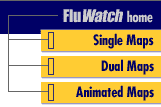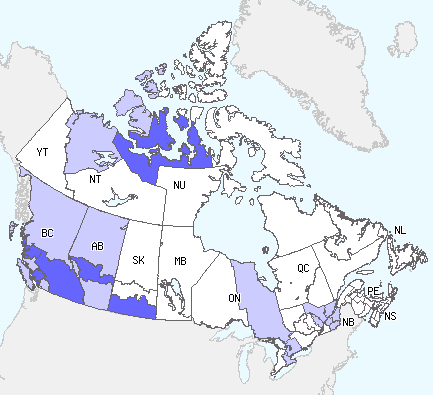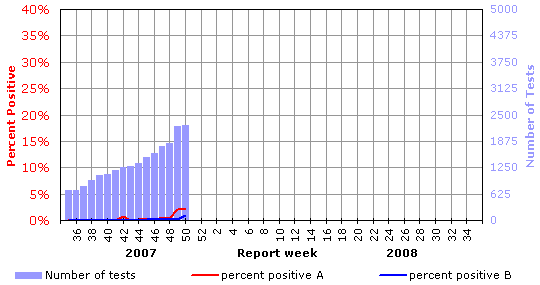Common menu bar links
E-mail this page
Fluwatch
Influenza activity in Canada is increasing but remains fairly low overall; influenza B detections increasing in the West
During week 50, influenza activity levels started to increase with 6 influenza surveillance regions (2 regions in British Columbia and 1 each in Alberta, Saskatchewan, Ontario and Nunavut) reporting localized influenza activity compared to only 1 or 2 regions in previous weeks. However, overall influenza activity in Canada still remains fairly low with the majority of regions reporting either no activity (n=46) or sporadic activity (n=16) (see map). In week 50, the proportion of positive influenza tests increased to 2.9% (67/2,244). Although the majority of influenza detections this week were for influenza A viruses (70% or 47/67), the proportion of influenza B detections started to increase this week as well. Of the influenza detections to date, 79% (131/166) were influenza A and 21% (35/166) were influenza B (see table). The ILI consultation rate continued to rise from previous weeks and was at 25 ILI consultations per 1,000 patient visits (see ILI graph), which is within the expected rate for this week. The sentinel response rate was 63%. Six new outbreaks were reported in week 50: 1 outbreak of influenza in a LTCF (Saskatchewan), 4 outbreaks of ILI in schools (3 in British Columbia and 1 in Alberta), and one community outbreak (Nunavut). Since the start of the season, no new laboratory-confirmed influenza-associated paediatric hospitalizations were reported through the Immunization Monitoring Program Active (IMPACT) network.
Antigenic Characterization:
The National Microbiology Laboratory (NML) has characterized 42 influenza viruses for the 2007-2008 influenza season: 27 A(H1N1), 6 A(H3N2) and 9 B viruses. All influenza A(H1N1) viruses were antigenically similar to A/Solomon Islands/3/2006. Of the 6 influenza A(H3N2) viruses characterized, 5 were antigenically similar to A/Wisconsin/67/2005 and 1 was antigenically similar to A/Brisbane/10/2007. One of the five A/Wisconsin-like viruses had reduced titer to A/Wisconsin/67/2005 reference antiserum. Of the 9 influenza B isolates characterized, 2 were antigenically similar to B/Malaysia/2506/2004 and 7 were antigenically similar to B/Florida/4/2006 (belonging to the B/Yamagata lineage) (see pie chart).
* The WHO recommends that the vaccines to be used in the 2007-2008 season (northern hemisphere) contain the following: an A/Solomon Islands/3/2006 (H1N1)-like virus; an A/Wisconsin/67/2005 (H3N2)-like virus; and a B/Malaysia/2506/2004-like (B/Victoria/2/1987 lineage) virus.
Antiviral Resistance:
Since the start of the season, the NML has tested 29 influenza A isolates (20 H1N1 and 9 H3N2) for amantadine resistance and found that 7 (78%) of the 9 H3N2 isolates were resistant to amantadine (originating from Ontario and Alberta) and all 20 H1N1 isolates were sensitive (see recommendation from the 2006-2007 influenza season below). Of the 33 isolates tested for oseltamivir resistance (24 influenza A, 9 influenza B), none were found to be resistant.
International:
CDC: A low level of influenza activity was reported in the United States during week 49 with only 6 states reporting local influenza activity and the majority reporting sporadic (n=32) and no influenza activity (n=11). The proportion of specimens that tested positive for influenza virus increased to 4.7% this week. The majority of influenza detections to date were for influenza A viruses (92%). Since September 30, 2007, CDC antigenically characterized 33 influenza viruses: 19 influenza A(H1) (all A/Solomon Islands/3/2006), 11 influenza A(H3) (4 A/Wisconsin/67/2005-like and 7 A/Brisbane/10/2007-like), and 3 influenza B viruses (all belonging to the B/Yamagata/16/1988 lineage). To date this season, 1 influenza-associated pediatric death has been reported to the CDC (in week 48).
EISS: The number of laboratory confirmed cases of influenza continues to increase, but clinical influenza activity in most of Europe remains low. Of the influenza virus detections since week 40, 78% were influenza A; of those that were sub-typed, 91% were A(H1). Based on the antigenic and/or genetic characterisation of 124 influenza viruses, 101 were A/Solomon Island/3/2006 (H1N1)-like, 7 were A/Brisbane/10/2007-like, 10 were B/Florida/4/2006-like (B/Yamagata/16/88 lineage) and 6 were B/Malaysia/2506/2004-like (B/Victoria/2/1987 lineage).
Human Avian Influenza: On 15 December, the WHO reported a summary of the investigation being conducted on 8 suspected human cases of H5N1 avian influenza infection in the Peshawar area of Pakistan. These cases were detected following a series of culling operations in response to outbreaks of H5N1 in poultry. One of the cases has now recovered and a further two suspected cases have since died. Samples taken from the suspected cases have tested positive for H5N1 in the national laboratory and are being forwarded to a WHO H5 Reference Laboratory for confirmation and further analysis. WHO is providing technical support to the MoH in epidemiological investigations, reviewing the surveillance, prevention and control measures that have been implemented and carrying out viral sequencing of avian and human isolates.
Recommendation for the Use of Amantadine for Treatment and Prevention of Influenza
The Public Health Agency of Canada does not recommend the use of amantadine for treatment or prevention of influenza for the 2006-2007 season. This recommendation will be revisited if new information becomes available.
Total number of influenza tests performed and number of positive tests by province/territory of testing laboratory, Canada, 2007-2008
| Province
of reporting laboratories |
Report
Period: December 9, 2007 to December 15, 2007 |
Season
to Date: August 26, 2007 to December 15, 2007 |
||||||
| Total
# Influenza Tests |
# of Positive Tests | Total
# Influenza Tests |
# of Positive Tests | |||||
| Influenza A | Influenza B | Total | Influenza A | Influenza B | Total | |||
| NL | 13 | 0 | 0 | 0 | 95 | 0 | 0 | 0 |
| PE | 0 | 0 | 0 | 0 | 25 | 0 | 0 | 0 |
| NS | 9 | 0 | 0 | 0 | 157 | 0 | 1 | 1 |
| NB | 0 | 0 | 0 | 0 | 158 | 0 | 0 | 0 |
| QC | 505 | 1 | 1 | 2 | 3758 | 9 | 4 | 13 |
| ON | 650 | 39 | 0 | 39 | 5851 | 90 | 2 | 92 |
| MB | 42 | 0 | 0 | 0 | 595 | 0 | 0 | 0 |
| SK | 129 | 3 | 0 | 3 | 1336 | 3 | 0 | 3 |
| AB | 831 | 1 | 18 | 19 | 8963 | 18 | 26 | 44 |
| BC | 65 | 3 | 1 | 4 | 594 | 11 | 2 | 13 |
| Canada | 2244 | 47 | 20 | 67 | 21532 | 131 | 35 | 166 |
Specimens from NT, YT, and NU are sent to reference laboratories in other provinces.
Note: Cumulative data includes updates to previous weeks; due to reporting delays, the sum of weekly report totals do not add up to cumulative totals.
Abbreviations: Newfoundland/Labrador (NL), Prince Edward Island (PE), New Brunswick (NB), Nova Scotia (NS), Quebec (QC), Ontario (ON), Manitoba (MB), Saskatchewan (SK), Alberta (AB), British Columbia (BC), Yukon (YT), Northwest Territories (NT), Nunavut (NU)
Respiratory virus laboratory detections in Canada, by geographic
regions, are available weekly on the following website:
<http://www.phac-aspc.gc.ca/bid-bmi/dsd-dsm/rvdi-divr/index-eng.php>
Number of influenza surveillance regions† reporting widespread or localized influenza activity, Canada, by report week, 2007-2008 (N=54)

![]()
† sub-regions within the province or territory as defined by the provincial/territorial epidemiologist. Graph may change as late returns come in.
Influenza
Activity Level by Provincial and Territorial |
||||||||||||
|
||||||||||||
Note: Influenza activity levels, as represented on this map, are assigned and reported by Provincial and Territorial Ministries of Health, based on laboratory confirmations, sentinel ILI rates (see graphs and tables) and outbreaks. Please refer to detailed definitions. For areas where no data is reported, late reports from these provinces and territories will appear on the FluWatch website. Select single maps by report week to get this updated information. Click on the map to view provinces/territories and maps for other weeks. |
|
Influenza tests reported and percentage of tests positive, Canada, by report week, 2007-2008
Percent positive influenza tests, compared to other respiratory viruses, Canada, by reporting week, 2007-2008
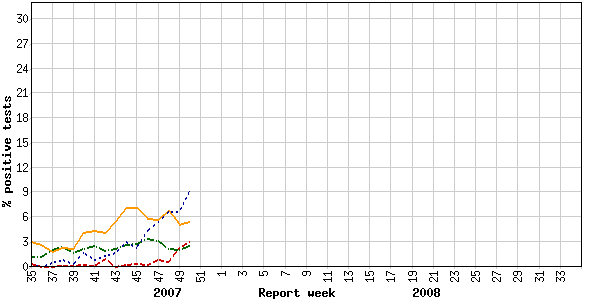
![]()
Influenza strain characterization, Canada, cumulative, 2007-2008 influenza season by the Respiratory Viruses Section at the National Microbiology Laboratory
[N=42]
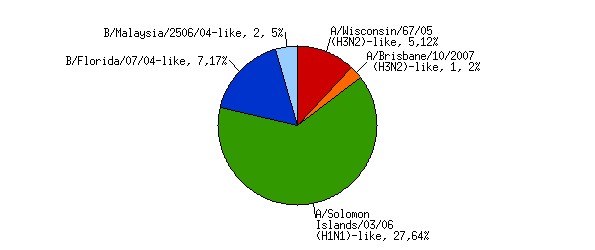
{Strain characterization, number identified, per cent of total number}
NACI recommends that the trivalent vaccine for the 2007-2008 season in Canada contain A/Solomon Islands/3/2006 (H1N1)-like virus; an A/Wisconsin/67/2005 (H3N2)-like virus; and a B/Malaysia/2506/2004-like virus.
Influenza-like illness (ILI) consultation rates, Canada, by report week, 2007-2008 compared to 1996/97 through to 2006/07 seasons
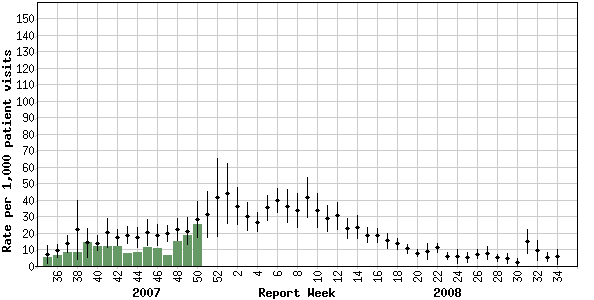
![]()
Note: No data available for mean rate in previous years for weeks 19 to 39 (1996-1997 through 2002-2003 seasons).
Number of New Outbreaks in Long Term Care Facilities, Canada, by Report Week, 2007-2008
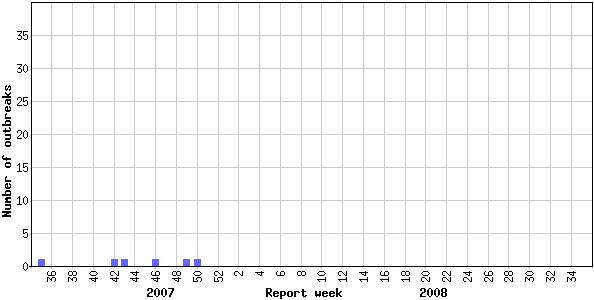
![]()
Please note that the above graphs may change as late returns come in.


